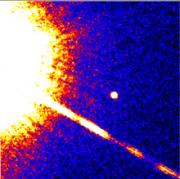Brown Dwarfs
Brown dwarfs are Janus-faced objects that straddle the mass range between stars and planets: sharing many characteristics with both but classifiable as neither, they offer fundamental insights into formation and properties in both the stellar and planetary regimes. Weighing in between 12 and 75 Jupiters, brown dwarfs are (like planets, and unlike stars) too light to fuse ordinary hydrogen nuclei. However (like stars, and unlike planets), they are heavy enough to fuse deuterium early in their lives. Newly formed brown dwarfs therefore shine like feeble stars, due to deuterium fusion, but then simply cool down and become fainter with time, like planets, once their supply of deuterium is exhausted. The size of young brown dwarfs, like that of stars, represents a balance between the inward pull of gravity and the outward push of thermal gas pressure. Older ones, like the most massive planets, settle into an equilibrium between gravity and the quantum pressure exerted by densely packed electrons in their core. The atmospheres of young brown dwarfs closely resemble those of low-mass stars; as they cool, however, they manifest exotic meteorological phenomena, such as the appearance of clouds, dust formation and settling, and precipitation, usually associated with planets. Astronomers have identified hundreds of these peculiar beasts, both young ones in star-forming regions as well as older ones in the neighborhood of our solar system. Indeed, it now appears that brown dwarfs, far from being rarities in the astronomical menagerie, may be nearly as common as sun-like stars. Most of them float through the galaxy independently (like stars), but a few inhabit orbits around stars (like planets). These objects allow us to address several fundamental questions in stellar and planetary physics. In particular: (1) the genesis of brown dwarfs poses a mystery, whose resolution is crucial to unraveling the processes underlying star formation in general; (2) their evolutionary properties tie together various phenomena - onset of core electron degeneracy, atmospheric opacities arising from complex molecular and grain chemistry and dynamics, strong convection, magnetic field behavior in predominantly neutral atmospheres - necessary for understanding both stellar and planetary evolution; (3) the discovery of disks girdling young brown dwarfs raises the fascinating prospect of forming planets around them, just like around stars; and (4) their ultra-cool atmospheres provide essential clues to conditions on extrasolar giant planets: an extremely important point, since the vast majority of known extrasolar planets are not directly observable with current technology (due to the presence of a much brighter central star), while similarly faint brown dwarfs, occuring in isolation, are much easier to observe.
Researchers at the CfA are involved in an exploration of all these issues, from both theoretical and observational standpoints, using the full panoply of current state-of-the-art telescope facilities (e.g., Spitzer, Magellan, Keck, VLT).
Charlie Lada, Phil Myers
Ongoing Collaborator: Eric Mamajek




